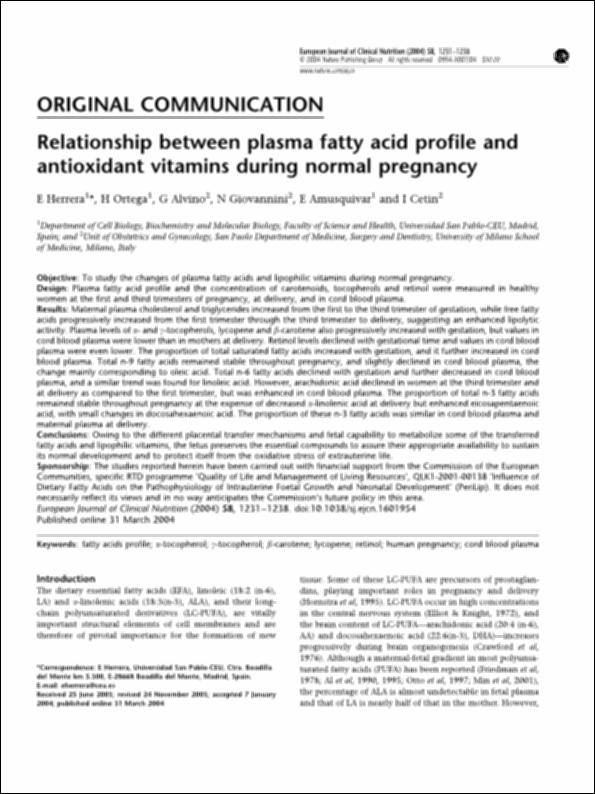Por favor, use este identificador para citar o enlazar este ítem:
http://hdl.handle.net/10637/1093Relationship between plama fatty acid profile and antioxidant vitamins during normal pregnancy.
| Título : | Relationship between plama fatty acid profile and antioxidant vitamins during normal pregnancy. |
| Autor : | Herrera Castillón, Emilio. Ortega Senovilla, Henar Alvino, Gioia Giovannini, N. Amusquivar Arias, Encarnación Cetin, Irene |
| Materias: | Fatty acids profile.; G-tocopherol.; B-carotene.; Lycopene.; Retinol.; Human pregnancy.; Cord blood plasma. |
| Resumen : | Objective: To study the changes of plasma fatty acids and lipophilic vitamins during normal pregnancy. Design: Plasma fatty acid profile and the concentration of carotenoids, tocopherols and retinol were measured in healthy women at the first and third trimesters of pregnancy, at delivery, and in cord blood plasma. Results: Maternal plasma cholesterol and triglycerides increased from the first to the third trimester of gestation, while free fatty acids progressively increased from the first trimester through the third trimester to delivery, suggesting an enhanced lipolytic activity. Plasma levels of a- and g-tocopherols, lycopene and b-carotene also progressively increased with gestation, but values in cord blood plasma were lower than in mothers at delivery. Retinol levels declined with gestational time and values in cord blood plasma were even lower. The proportion of total saturated fatty acids increased with gestation, and it further increased in cord blood plasma. Total n-9 fatty acids remained stable throughout pregnancy, and slightly declined in cord blood plasma, the change mainly corresponding to oleic acid. Total n-6 fatty acids declined with gestation and further decreased in cord blood plasma, and a similar trend was found for linoleic acid. However, arachidonic acid declined in women at the third trimester and at delivery as compared to the first trimester, but was enhanced in cord blood plasma. The proportion of total n-3 fatty acids remained stable throughout pregnancy at the expense of decreased a-linolenic acid at delivery but enhanced eicosapentaenoic acid, with small changes in docosahexaenoic acid. The proportion of these n-3 fatty acids was similar in cord blood plasma and maternal plasma at delivery. Conclusions: Owing to the different placental transfer mechanisms and fetal capability to metabolize some of the transferred fatty acids and lipophilic vitamins, the fetus preserves the essential compounds to assure their appropriate availability to sustain its normal development and to protect itself from the oxidative stress of extrauterine life. Sponsorship: The studies reported herein have been carried out with financial support from the Commission of the European Communities, specific RTD programme ‘Quality of Life and Management of Living Resources’, QLK1-2001-00138 ‘Influence of Dietary Fatty Acids on the Pathophysiology of Intrauterine Foetal Growth and Neonatal Development’ (PeriLip). It does not necessarily reflect its views and in no way anticipates the Commission’s future policy in this area. |
| Descripción : | En: European journal of clinical nutrition. 2004. n. 58 : 1231-1238 p. 0954-3007 |
| URI : | http://hdl.handle.net/10637/1093 |
| Derechos: | http://creativecommons.org/licenses/by-nc-nd/4.0/deed.es |
| Fecha de publicación : | 19-sep-2004 |
| Centro : | Universidad San Pablo-CEU |
| Aparece en las colecciones: | Facultad de Farmacia |
Los ítems de DSpace están protegidos por copyright, con todos los derechos reservados, a menos que se indique lo contrario.


